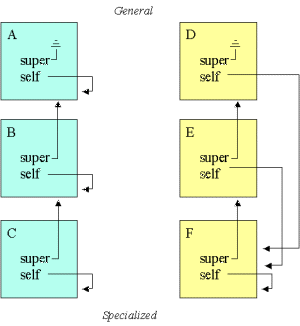a. 类和对象 函数定义可以解释为一个类,并且函数调用可以扮演对象的角色。换句话说,lambda表达式可以被视为类,而闭包可以被视为对象。
下面定义一个 point 类,lambda表达式将作为 point 类的实例对象句柄返回。这个对象句柄实际上是一个调度程序,它在给定message参数作为输入的情况下返回匹配的方法。
1 2 3 4 5 6 7 8 9 10 11 12 13 14 (define point x y) (letrec getx (lambda (gety (lambda (add (lambda (point (+ send 'getx p)) (+ send 'gety p))))) (type-of (lambda 'point ))) (lambda (cond eq? 'getx ) getx) ((eq? 'gety ) gety) ((eq? 'add ) add) ((eq? 'type-of ) type-of) (else error #f "Message not understood" ))))))
在 add 方法中,我们使用 send 函数向对象发送消息。 send 函数仅查找方法,并使用 apply 来调用方法。
1 2 3 (define send message obj . par) (let method (obj message))) (apply
b. 类的通用模式 一个类通常包含:构造参数、实例变量、方法和self方法。方法除了通过上面的 letrec 定义外,还可以通过 define 来简化定义。
1 2 3 4 5 6 7 8 9 10 11 12 13 14 15 16 (define class-name construction-parameters) (let instance-var init-value) ...) (define method parameter-list) method-body) ... (define self message) (cond eqv? ... (else error #f "Undefined message" message)))) self))
我们再实现一个实例化对象的函数,顺便给 send 函数增加一点错误处理能力。
1 2 3 4 5 6 7 (define new-instance class . parameters) (apply (define send message object . args) (let method (object message))) (cond procedure? apply (else error #f "Error in method lookup " method)))))
c. 类的示例 现在我们重新写一下 point 类
1 2 3 4 5 6 7 8 9 10 11 12 13 14 15 16 17 18 19 20 21 22 23 (define point x y) (let x x) (y y)) (define getx ) x) (define gety ) y) (define add p) (point (+ send 'getx p)) (+ send 'gety p)))) (define type-of ) 'point ) (define self message) (cond eqv? 'getx ) getx) ((eqv? 'gety ) gety) ((eqv? 'add ) add) ((eqv? 'type-of ) type-of) (else error #f "Undefined message" message)))) self))
下面我们模拟一个场景,其中我们创建了两个点,并将它们绑定到变量 p 和 q ,再将 p 与 q 的和绑定到变量 p+q 。最后我们通过 send 发送 getx 和 gety 消息来检查结果是否符合预期。
1 2 3 4 5 6 7 8 9 10 11 12 13 14 1 > (define new-instance point 2 3 ))2 > (send 'getx p)2 3 > (define new-instance point 4 5 ))4 > (define send 'add p q))5 > (send 'getx p+q)6 6 > (send 'gety p+q)8
d. 继承 上面我们已经在Scheme中简单的模拟了类和对象,继承是面向对象中更高级的概念。
我们先将对象简单的分成两部分 super (super part)和 self (subclass part)。基类的对象是上半部分,我们将其绑定到 super ,分派器 dispatch 作为下半部分仍然绑定到 self 。
1 2 3 4 5 6 7 8 9 10 11 12 13 14 15 16 17 18 (define class-name parameters) (let super (new-part super-class-name some-parameters)) (self 'nil )) (let instance-variable init-value) ...) (define method parameter-list) method-body) ... (define dispatch message) (cond eqv? 'selector ) method) ... (else method-lookup super message)))) (set! self))
下面将实现一个大多数面向对象语言中都有的基础类 object 。所有对象可以通过继承形成一个 super 链, object 的 super 为空,作为整个 super 派发链的终结。
1 2 3 4 5 6 7 8 9 (define object ) (let super '()) (self 'nil )) (define dispatch message) '()) (set! self))
我们再添加 new-instance 、 new-part 、 send 和 method-lookup 这几个函数来对面向对象做更完善的支持。 new-part 用于构造对象的部件,而 new-instance 用于构造具体类型的对象,这里暂时看上去长得一样。
1 2 3 4 5 6 7 8 9 10 11 12 13 14 15 16 17 18 19 20 (define new-instance class . parameters) (apply (define new-part class . parameters) (apply (define method-lookup object selector) (cond procedure? object selector)) (else (error #f "Inappropriate object in method-lookup: " object)))) (define send message object . args) (let method (method-lookup object message))) (cond procedure? apply ((null? (error #f "Message not understood: " message)) (else (error #f "Inappropriate result of method lookup: " method)))))
e. 继承的示例 我们借用c小节的示例 point 类型,在此基础上,我们通过继承来派生出一个带颜色的点 color-point 类型。
1 2 3 4 5 6 7 8 9 10 11 12 13 14 15 16 17 18 (define color-point x y color) (let super (new-part point x y)) (self 'nil )) (let color color)) (define get-color ) color) (define type-of ) 'color-point ) (define dispatch message) (cond eqv? 'get-color ) get-color) ((eqv? 'type-of ) type-of) (else method-lookup super message)))) (set! self))
测试下我们的颜色点,并将两个颜色点相加(注意,两个颜色点相加后不是颜色点,只是普通的点)
1 2 3 4 5 6 7 8 9 10 11 12 13 14 15 16 17 18 19 20 21 22 23 24 1 > (define new-instance color-point 5 6 'red ))2 > (send 'get-color cp)red 3 > (send 'getx cp)5 4 > (send 'gety cp)6 5 > (define send 'add cp (new-instance color-point 1 2 'green )))6 > (send 'getx cp-1)6 7 > (send 'gety cp-1)8 8 > (send 'type-of cp-1)point 9 > (send 'get-color cp-1)Undefined message get-color
f. self解释 继承的模拟涉及将对象部分聚合为整体对象。为了将整个对象绑定在一起, self 所有部分的(对象句柄)必须指向最专门的对象部分。
图中展示了我们想要实现的目标。左侧的绿色层次结构显示了现在的情况,其中 self 每个级别均指向当前对象部分。右侧的黄色层次结构显示了我们希望建立的情况。
self 必须指向最顶层的对象部分,如果不是这样,就根本无法从“非顶层对象部分”访问“顶层对象部分”
g. 虚拟方法示例 现在展示虚拟方法的效果。我们将定义一个基类 x ,一个子类 y ( y 继承自 x )。在这2个对象中,我们都将看到一个额外的方法 set-self! ,该方法负责将 self 更改为适当的对象。注意!使用 x 和 y 类的程序员对 set-self! 不感兴趣,所以 set-self! 方法是对象的内部事务。
1 2 3 4 5 6 7 8 9 10 11 12 13 14 15 16 17 18 19 20 21 22 (define x ) (let super (new-part object)) (self 'nil )) (let x-state 1 )) (define get-state ) x-state) (define res ) (send 'get-state self)) (define set-self! object-part) (set! (send 'set-self! super object-part)) (define self message) (cond eqv? 'get-state ) get-state) ((eqv? 'res ) res) ((eqv? 'set-self! ) set-self!) (else method-lookup super message)))) self)))
1 2 3 4 5 6 7 8 9 10 11 12 13 14 15 16 17 18 (define y ) (let super (new-part x)) (self 'nil )) (let y-state 2 )) (define get-state ) y-state) (define set-self! object-part) (set! (send 'set-self! super object-part)) (define self message) (cond eqv? 'get-state ) get-state) ((eqv? 'set-self! ) set-self!) (else method-lookup super message)))) self)))
下面是一个小示例,它可以解释 self 的效果。将 res 消息发送到 y 对象 b 会得到值 2 ,表明该 res 方法调用了 y 对象的 get-state (不是 x 的 get-state )。 y 的 res 方法是从 x 继承而来。
1 2 3 4 5 6 7 8 9 1 > (define new-instance x))2 > (define new-instance y))3 > (send 'res a)1 4 > (send 'res b)2
为了得到上面示例的结果,我们对 new-instance 函数还需要做一些小小的修改。我们在 new-instance 中调用一个 virtual-operations 的函数,该函数将 set-self! 消息发送到对象,这将依次激活所有级别对象的 set-self! 方法。
1 2 3 4 5 6 7 (define new-instance class . parameters) (let instance (apply (virtual-operations instance) instance)) (define virtual-operations object) (send 'set-self! object object))
h. 面向对象的一些思考 这里只是在Scheme中对面向对象的一个简单模拟。在此基础上,我们还可以实现一个更完善的面向对象系统。例如:
通过槽( Slot )来管理属性和方法(槽是Key/Value对的列表)
所有的动作( actions )都是消息
对象与对象之间只能通过消息来交互
基于原型链( Prototypes )的方式实现继承(当对象收到一条消息时,它会寻找一个匹配的槽,如果找不到,则查找将首先在其原型中递归地继续进行)
多重继承只需要将原型添加到对象的原型链中即可(当响应消息时,查找机制对原型链进行深度优先搜索)
对象的继承和实例化可以都通过复制( clone )的方式进行
i. 参考资料 示例代码(Github)
CLOS
CLOS for Chez-Scheme
Simulation of object-oriented mechanisms in Scheme - A technical report
